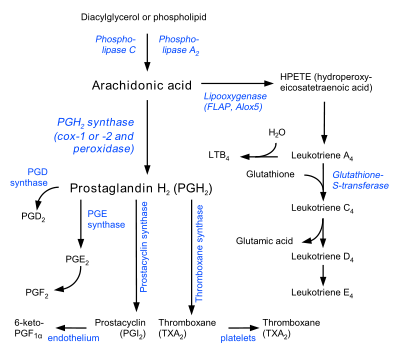
Thromboxane
Encyclopedia


Thromboxane A2
Thromboxane A2 is a thromboxane. It is produced by activated platelets and has prothrombotic properties: it stimulates activation of new platelets as well as increases platelet aggregation. This is achieved by mediating expression of the glycoprotein complex GP IIb/IIIa in the cell membrane of...
and thromboxane B2
Thromboxane B2
Thromboxane B2 is an inactive metabolite/product of thromboxane A2. It is almost completely cleared in the urine.It itself is not involved in platelet activation and aggregation in case of a wound, but its precursor, thromboxane A2, is. Thromboxane A2 synthesis is the target of the drug aspirin,...
. The distinguishing feature of thromboxanes is a 6-membered ether
Ether
Ethers are a class of organic compounds that contain an ether group — an oxygen atom connected to two alkyl or aryl groups — of general formula R–O–R'. A typical example is the solvent and anesthetic diethyl ether, commonly referred to simply as "ether"...
-containing ring.
Thromboxane is named for its role in clot formation (thrombosis
Thrombosis
Thrombosis is the formation of a blood clot inside a blood vessel, obstructing the flow of blood through the circulatory system. When a blood vessel is injured, the body uses platelets and fibrin to form a blood clot to prevent blood loss...
).
Production


Thromboxane-A synthase
Thromboxane A synthase 1 , also known as TBXAS1, is an enzyme that, in humans, is encoded by the TBXAS1 gene.- Function :This gene encodes a member of the cytochrome P450 superfamily of enzymes...
, an enzyme found in platelets, converts the arachidonic acid
Arachidonic acid
Arachidonic acid is a polyunsaturated omega-6 fatty acid 20:4.It is the counterpart to the saturated arachidic acid found in peanut oil, Arachidonic acid (AA, sometimes ARA) is a polyunsaturated omega-6 fatty acid 20:4(ω-6).It is the counterpart to the saturated arachidic acid found in peanut oil,...
derivative prostaglandin H2
Prostaglandin H2
Prostaglandin H2 is a type of Prostaglandin which is derived from arachidonic acid and is a precursor for many other biologically significant molecules.It is acted upon by:* prostacyclin synthase to create prostacyclin...
to thromboxane.
Mechanism
Thromboxane acts by binding to any of the thromboxane receptorThromboxane receptor
The thromboxane receptor is a protein on the surface of cells in the endothelium of blood vessels and in the placenta which interacts with the eicosanoid lipid thromboxane. It is a G-protein coupled receptor coupled to the G protein Gq.-Gene:...
s, G-protein-coupled receptors coupled to the G protein
G protein
G proteins are a family of proteins involved in transmitting chemical signals outside the cell, and causing changes inside the cell. They communicate signals from many hormones, neurotransmitters, and other signaling factors. G protein-coupled receptors are transmembrane receptors...
Gq
Gq alpha subunit
Gq protein or Gq/11 is a heterotrimeric G protein subunit that activates phospholipase C . PLC in turn hydrolyzes Phosphatidylinositol 4,5-bisphosphate to diacyl glycerol and inositol triphosphate signal transduction pathway...
.
Functions
Thromboxane is a vasoconstrictor and a potent hypertensive agent, and it facilitates platelet aggregation.It is in homeostatic balance in the circulatory system
Circulatory system
The circulatory system is an organ system that passes nutrients , gases, hormones, blood cells, etc...
with prostacyclin
Prostacyclin
Prostacyclin is a member of the family of lipid molecules known as eicosanoids.As a drug, it is also known as "epoprostenol". The terms are sometimes used interchangeably.-History:...
, a related compound.
The mechanism of secretion of thromboxanes from platelets is still unclear.
Role of A2 in platelet aggregation
Thromboxane A2Thromboxane A2
Thromboxane A2 is a thromboxane. It is produced by activated platelets and has prothrombotic properties: it stimulates activation of new platelets as well as increases platelet aggregation. This is achieved by mediating expression of the glycoprotein complex GP IIb/IIIa in the cell membrane of...
(TXA2), produced by activated platelets, has prothrombotic properties, stimulating activation of new platelets as well as increasing platelet aggregation.
Platelet aggregation is achieved by mediating expression of the glycoprotein complex GP IIb/IIIa
Glycoprotein IIb/IIIa
In medicine, glycoprotein IIb/IIIa is an integrin complex found on platelets. It is a receptor for fibrinogen and aids in platelet activation. The complex is formed via calcium-dependent association of gpIIb and gpIIIa, a required step in normal platelet aggregation and endothelial adherence...
in the cell membrane of platelets. Circulating fibrinogen
Fibrinogen
Fibrinogen is a soluble plasma glycoprotein, synthesised by the liver, that is converted by thrombin into fibrin during blood coagulation. This is achieved through processes in the coagulation cascade that activate the zymogen prothrombin to the serine protease thrombin, which is responsible for...
binds these receptors on adjacent platelets, further strengthening the clot.
Pathology
It is believed that the vasoconstriction caused by thromboxanes plays a role in Prinzmetal's anginaPrinzmetal's angina
Prinzmetal angina, also known as variant angina or angina inversa, is a syndrome typically consisting of angina at rest that occurs in cycles...
. Omega-3 fatty acid
Omega-3 fatty acid
N−3 fatty acids are essential unsaturated fatty acids with a double bond starting after the third carbon atom from the end of the carbon chain....
s have higher levels of TxA,3 which is relatively less potent than TxA2 and PGI3; therefore, there is a balance shift toward vasoconstriction and platelet aggregation inhibition. It is believed that this shift in balance lowers the incidence of myocardial infarction and stroke.
Inhibitors
Thromboxane inhibitors are broadly classified as either those that inhibit the synthesis of thromboxane, or those that inhibit the target effect of it.
Thromboxane synthesis inhibitors, in turn, can be classified regarding which step in the synthesis they inhibit:
- The widely used drug aspirinAspirinAspirin , also known as acetylsalicylic acid , is a salicylate drug, often used as an analgesic to relieve minor aches and pains, as an antipyretic to reduce fever, and as an anti-inflammatory medication. It was discovered by Arthur Eichengrun, a chemist with the German company Bayer...
acts by inhibiting the ability of the COX enzyme to synthesize the precursors of thromboxane within platelets. Low-dose, long-term aspirin use irreversibly blocks the formation of thromboxane A2Thromboxane A2Thromboxane A2 is a thromboxane. It is produced by activated platelets and has prothrombotic properties: it stimulates activation of new platelets as well as increases platelet aggregation. This is achieved by mediating expression of the glycoprotein complex GP IIb/IIIa in the cell membrane of...
in plateletPlateletPlatelets, or thrombocytes , are small,irregularly shaped clear cell fragments , 2–3 µm in diameter, which are derived from fragmentation of precursor megakaryocytes. The average lifespan of a platelet is normally just 5 to 9 days...
s, producing an inhibitory effect on platelet aggregationPlateletPlatelets, or thrombocytes , are small,irregularly shaped clear cell fragments , 2–3 µm in diameter, which are derived from fragmentation of precursor megakaryocytes. The average lifespan of a platelet is normally just 5 to 9 days...
. This anticoagulant property makes aspirin useful for reducing the incidence of heart attacks. 40 mg of aspirin a day is able to inhibit a large proportion of maximum thromboxane A2 release provoked acutely, with the prostaglandin I2 synthesis being little affected; however, higher doses of aspirin are required to attain further inhibition. - Thromboxane synthase inhibitors inhibit the final enzyme (thromboxane synthase) in the synthesis of thromboxane. IfetrobanIfetrobanIfetroban is a potent and selective thromboxane receptor antagonist....
is a potent and selective thromboxane receptor antagonist. DipyridamoleDipyridamoleDipyridamole is a drug that inhibits thrombus formation when given chronically and causes vasodilation when given at high doses over a short time.-Mechanism and effects:...
antagonizes this receptor too, but has various other mechanisms of antiplatelet activity as well.
The inhibitors of the target effects of thromboxane are the thromboxane receptor antagonist, including terutroban
Terutroban
Terutroban is an antiplatelet agent developed by Servier Laboratories. , it is being tested for the secondary prevention of acute thrombotic complications in the Phase III clinical trial PERFORM .-Method of...
.
Picotamide
Picotamide
Picotamide is a platelet aggregation inhibitor. It works as a thromboxane synthase inhibitor and a thromboxane receptor inhibitor, the latter by modifying cellular responses to activation of the thromboxane receptor....
has activity both as a thromboxane synthase inhibitor and as a thromboxane receptor antagonist.

